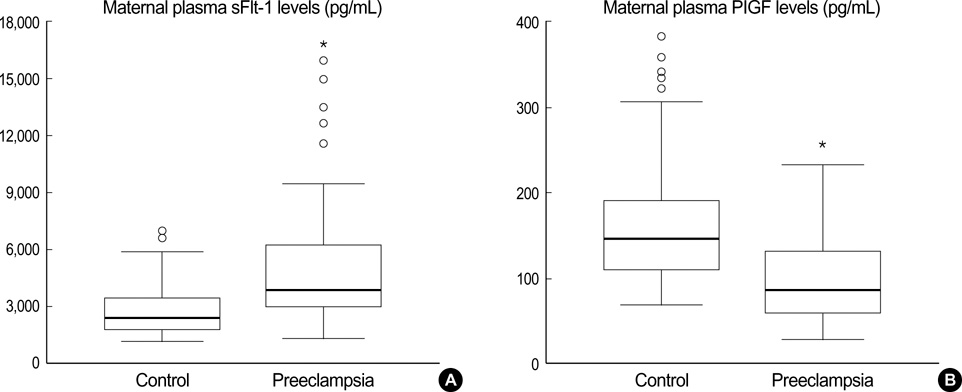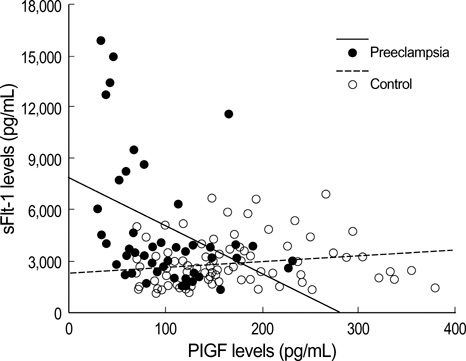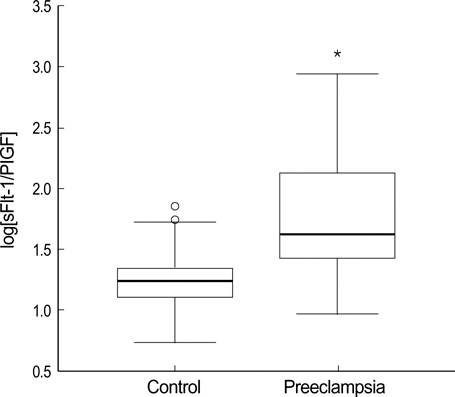J Korean Med Sci.
2007 Oct;22(5):873-877. 10.3346/jkms.2007.22.5.873.
Increased sFlt-1 to PlGF Ratio in Women Who Subsequently Develop Preeclampsia
- Affiliations
-
- 1Laboratory of Medical Genetics, Cheil General Hospital and Women's Healthcare Center, Kwandong University School of Medicine, Seoul, Korea.
- 2Department of Obstetrics and Gynecology, Cheil General Hospital and Women's Healthcare Center, Kwandong University School of Medicine, Seoul, Korea. hmryu@yahoo.com
- KMID: 1713296
- DOI: http://doi.org/10.3346/jkms.2007.22.5.873
Abstract
- The purpose of this study was to determine whether the levels of soluble fms-like tyrosine kinase-1 (sFlt-1) and placenta growth factor (PlGF) are altered during the second trimester in the plasma of women who subsequently develop preeclampsia. We performed a case-control study to compare the levels of sFlt-1 and PlGF in the preeclamptic (n=46) and normal pregnant women (n=100). The maternal plasma levels of sFlt-1 and PlGF were measured by enzyme-linked immunosorbent assay. The sFlt-1 levels were significantly higher in the preeclamptic women than in normal controls (p<0.001), while the PlGF levels were significantly lower (p<0.001). In normal controls, sFlt-1 levels were positively correlated (r=0.27, p=0.008), whereas, in the preeclamptic women, those were negatively correlated with the PlGF levels (r=-0.423, p=0.005). Furthermore, the log[sFlt-1/PlGF] ratio was significantly higher in the preeclamptic women than in normal controls (p<0.001). The receiver operating characteristic curve revealed a specificity of 78% with a diagnostic sensitivity of 80.4%; the optimal cut-off value of the log[sFlt-1/PlGF] ratio was 1.4 (95% CI 0.756-0.910, p<0.001). Preeclampsia showed a strong association with increased levels of sFlt-1 and decreased levels of PlGF in the second trimester maternal plasma. Accordingly, the sFlt-1/PlGF ratio may provide early prediction of subsequent development of preeclampsia.
MeSH Terms
-
Adult
Biological Markers/metabolism
Case-Control Studies
Female
Humans
Immunoassay
Middle Aged
Placenta/metabolism
Pre-Eclampsia/*diagnosis/*metabolism
Pregnancy
Pregnancy Proteins/*biosynthesis
Pregnancy Trimester, Second
ROC Curve
Sensitivity and Specificity
Vascular Endothelial Growth Factor Receptor-1/*biosynthesis
Figure
Reference
-
1. Levine RJ, Maynard SE, Qian C, Lim KH, England LJ, Yu KF, Schisterman EF, Thadhani R, Sachs BP, Epstein FH, Sibai BM, Sukhatme VP, Karumanchi SA. Circulating angiogenic factors and the risk of preeclampsia. N Engl J Med. 2004. 350:672–683.
Article2. McKeeman GC, Ardill JE, Caldwell CM, Hunter AJ, McClure N. Soluble vascular endothelial growth factor receptor-1 (sFlt-1) is increased throughout gestation in patients who have preeclampsia develop. Am J Obstet Gynecol. 2004. 191:1240–1246.
Article3. Thadhani R, Mutter WP, Wolf M, Levine RJ, Taylor RN, Sukhatme VP, Ecker J, Karumanchi SA. First trimester placental growth factor and soluble fms-like tyrosine kinase 1 and risk for preeclampsia. J Clin Endocrinol Metab. 2004. 89:770–775.
Article4. Taylor RN, Grimwood J, Taylor RS, McMaster MT, Fisher SJ, North RA. Longitudinal serum concentrations of placental growth factor: evidence for abnormal placental angiogenesis in pathologic pregnancies. Am J Obstet Gynecol. 2003. 188:177–182.
Article5. Kendall RL, Thomas KA. Inhibition of vascular endothelial cell growth factor activity by an endogenously encoded soluble receptor. Proc Natl Acad Sci USA. 1993. 90:10705–10709.
Article6. Cao Y, Chen A, An SS, Ji RW, Davidson D, Llinas M. Kringle 5 of plasminogen is a novel inhibitor of endothelial cell growth. J Biol Chem. 1997. 272:22924–22928.
Article7. Park JE, Chen HH, Winer J, Houck KA, Ferrara N. Placenta growth factor. Potentiation of vascular endothelial growth factor bioactivity, in vitro and in vivo, and high affinity binding to Flt-1 but not to Flk-1/KDR. J Biol Chem. 1994. 269:25646–25654.
Article8. Maynard SE, Min JY, Merchan J, Lim KH, Li J, Mondal S, Libermann TA, Morgan JP, Sellke FW, Stillman IE, Epstein FH, Sukhatme VP, Karumanchi SA. Excess placental soluble fms-like tyrosine kinase 1 (sFlt1) may contribute to endothelial dysfunction, hypertension, and proteinuria in preeclampsia. J Clin Invest. 2003. 111:649–658.
Article9. Chaiworapongsa T, Romero R, Espinoza J, Bujold E, Mee Kim Y, Goncalves LF, Gomez R, Edwin S. Evidence supporting a role for blockade of the vascular endothelial growth factor system in the pathophysiology of preeclampsia. Am J Obstet Gynecol. 2004. 190:1541–1547.
Article10. Koga K, Osuga Y, Yoshino O, Hirota Y, Ruimeng X, Hirata T, Takeda S, Yano T, Tsutsumi O, Taketani Y. Elevated serum soluble vascular endothelial growth factor receptor 1 (sVEGFR-1) levels in women with preeclampsia. J Clin Endocrinol Metab. 2003. 88:2348–2351.
Article11. Zhou Y, McMaster M, Woo K, Janatpour M, Perry J, Karpanen T, Alitalo K, Damsky C, Fisher SJ. Vascular endothelial growth factor ligands and receptors that regulate human cytotrophoblast survival are dysregulated in severe preeclampsia and hemolysis, elevated liver enzymes, and low platelets syndrome. Am J Pathol. 2002. 160:1405–1423.
Article12. Helske S, Vuorela P, Carpen O, Hornig C, Weich H, Halmesmaki E. Expression of vascular endothelial growth factor receptors 1, 2 and 3 in placentas from normal and complicated pregnancies. Mol Hum Reprod. 2001. 7:205–210.
Article13. Su YN, Lee CN, Cheng WF, Shau WY, Chow SN, Hsieh FJ. Decreased maternal serum placenta growth factor in early second trimester and preeclampsia. Obstet Gynecol. 2001. 97:898–904.
Article14. Chappell LC, Seed PT, Briley A, Kelly FJ, Hunt BJ, Charnock-Jones DS, Mallet AI, Poston L. A longitudinal study of biochemical variables in women at risk of preeclampsia. Am J Obstet Gynecol. 2002. 187:127–136.
Article15. Polliotti BM, Fry AG, Saller DN, Mooney RA, Cox C, Miller RK. Second-trimester maternal serum placental growth factor and vascular endothelial growth factor for predicting severe, early-onset preeclampsia. Obstet Gynecol. 2003. 101:1266–1274.
Article16. Krauss T, Pauer HU, Augustin HG. Prospective analysis of placenta growth factor (PlGF) concentrations in the plasma of women with normal pregnancy and pregnancies complicated by preeclampsia. Hypertens Pregnancy. 2004. 23:101–111.
Article17. Bersinger NA, Odegard RA. Second- and third-trimester serum levels of placental proteins in preeclampsia and small-for-gestational age pregnancies. Acta Obstet Gynecol Scand. 2004. 83:37–45.
Article18. Buhimschi CS, Norwitz ER, Funai E, Richman S, Guller S, Lockwood CJ, Buhimschi IA. Urinary angiogenic factors cluster hypertensive disorders and identify women with severe preeclampsia. Am J Obstet Gynecol. 2005. 192:734–741.
Article19. Shore VH, Wang TH, Wang CL, Torry RJ, Caudle MR, Torry DS. Vascular endothelial growth factor, placenta growth factor and their receptors in isolated human trophoblast. Placenta. 1997. 18:657–665.
Article20. Ahmed A, Dunk C, Ahmad S, Khaliq A. Regulation of placental vascular endothelial growth factor (VEGF) and placenta growth factor (PIGF) and soluble Flt-1 by oxygen--a review. Placenta. 2000. 21:Suppl A. S16–S24.21. Eskes TK. Abruptio placentae. A "classic" dedicated to Elizabeth Ramsey. Eur J Obstet Gynecol Reprod Biol. 1997. 75:63–70.22. Dommisse J, Tiltman AJ. Placental bed biopsies in placental abruption. Br J Obstet Gynaecol. 1992. 99:651–654.
Article
- Full Text Links
- Actions
-
Cited
- CITED
-
- Close
- Share
- Similar articles
-
- Associations between Maternal sFlt-1/PlGF Ratio and Perinatal and Neonatal Outcomes in Newborns Born to Mothers with Preeclampsia
- Cord Blood Soluble fms-Like Tyrosine Kinase 1 and Placental Growth Factor in Preterm Infants with Maternal Preeclampsia
- Clinical usefulness of soluble fms-like tyrosine kinase 1, soluble endoglin and placental growth factor in Korean women with preeclampsia
- Evaluation of sFlt-1/PlGF Ratio for Predicting and Improving Clinical Management of Pre-eclampsia: Experience in a Specialized Perinatal Care Center
- The Levels of Circulating Vascular Endothelial Growth Factor and Soluble Flt-1 in Pregnancies Complicated by Preeclampsia





